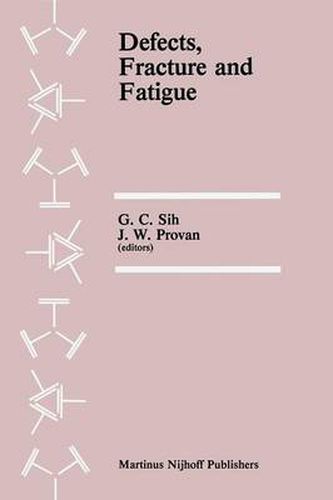Readings Newsletter
Become a Readings Member to make your shopping experience even easier.
Sign in or sign up for free!
You’re not far away from qualifying for FREE standard shipping within Australia
You’ve qualified for FREE standard shipping within Australia
The cart is loading…






This title is printed to order. This book may have been self-published. If so, we cannot guarantee the quality of the content. In the main most books will have gone through the editing process however some may not. We therefore suggest that you be aware of this before ordering this book. If in doubt check either the author or publisher’s details as we are unable to accept any returns unless they are faulty. Please contact us if you have any questions.
The Second International Symposium on Defects, Fracture and Fatigue took place at Mont Gabriel, Quebec, Canada, May 30 to June 5, 1982, and was organized by the Mechanical Engineering Department of McGill University and Institute of Fracture and Solid Mechanics, Lehigh University. The Co-Chairmen of the Sympo- sium were Professor G. C. Sih of Lehigh University and Professor J. W. Provan of McGill University. Among those who served on the Organizing Committee were G. C. Sih (Co-Chairman), J. W. Provan (Co-Chairman), H. Mughrabi, H. Zorski, R. Bullough, M. Matczynski, G. Barenblatt and G. Caglioti. As a result of the interest expressed at the First Symposium that was held in October 1980, in Po- land, the need for a follow-up meeting to further explore the phenomena of mate- rial damage became apparent. Among the areas considered were dislocations, per- sistent-slip-bands, void creation, microcracking, microstructure effects, micro/ macro fracture mechanics, ductile fracture criteria, fatigue crack initiation and propagation, stress and failure analysis, deterministic and statistical crack models, and fracture control. This wide spectrum of topics attracted researchers and engineers in solid state physics, continuum mechanics, applied mathematics, metallurgy and fracture mechanics from many different countries. This spectrum is also indicative of the interdisciplinary character of material damage that must be addressed at the atomic, microscopic and macroscopic scale level.
$9.00 standard shipping within Australia
FREE standard shipping within Australia for orders over $100.00
Express & International shipping calculated at checkout
This title is printed to order. This book may have been self-published. If so, we cannot guarantee the quality of the content. In the main most books will have gone through the editing process however some may not. We therefore suggest that you be aware of this before ordering this book. If in doubt check either the author or publisher’s details as we are unable to accept any returns unless they are faulty. Please contact us if you have any questions.
The Second International Symposium on Defects, Fracture and Fatigue took place at Mont Gabriel, Quebec, Canada, May 30 to June 5, 1982, and was organized by the Mechanical Engineering Department of McGill University and Institute of Fracture and Solid Mechanics, Lehigh University. The Co-Chairmen of the Sympo- sium were Professor G. C. Sih of Lehigh University and Professor J. W. Provan of McGill University. Among those who served on the Organizing Committee were G. C. Sih (Co-Chairman), J. W. Provan (Co-Chairman), H. Mughrabi, H. Zorski, R. Bullough, M. Matczynski, G. Barenblatt and G. Caglioti. As a result of the interest expressed at the First Symposium that was held in October 1980, in Po- land, the need for a follow-up meeting to further explore the phenomena of mate- rial damage became apparent. Among the areas considered were dislocations, per- sistent-slip-bands, void creation, microcracking, microstructure effects, micro/ macro fracture mechanics, ductile fracture criteria, fatigue crack initiation and propagation, stress and failure analysis, deterministic and statistical crack models, and fracture control. This wide spectrum of topics attracted researchers and engineers in solid state physics, continuum mechanics, applied mathematics, metallurgy and fracture mechanics from many different countries. This spectrum is also indicative of the interdisciplinary character of material damage that must be addressed at the atomic, microscopic and macroscopic scale level.